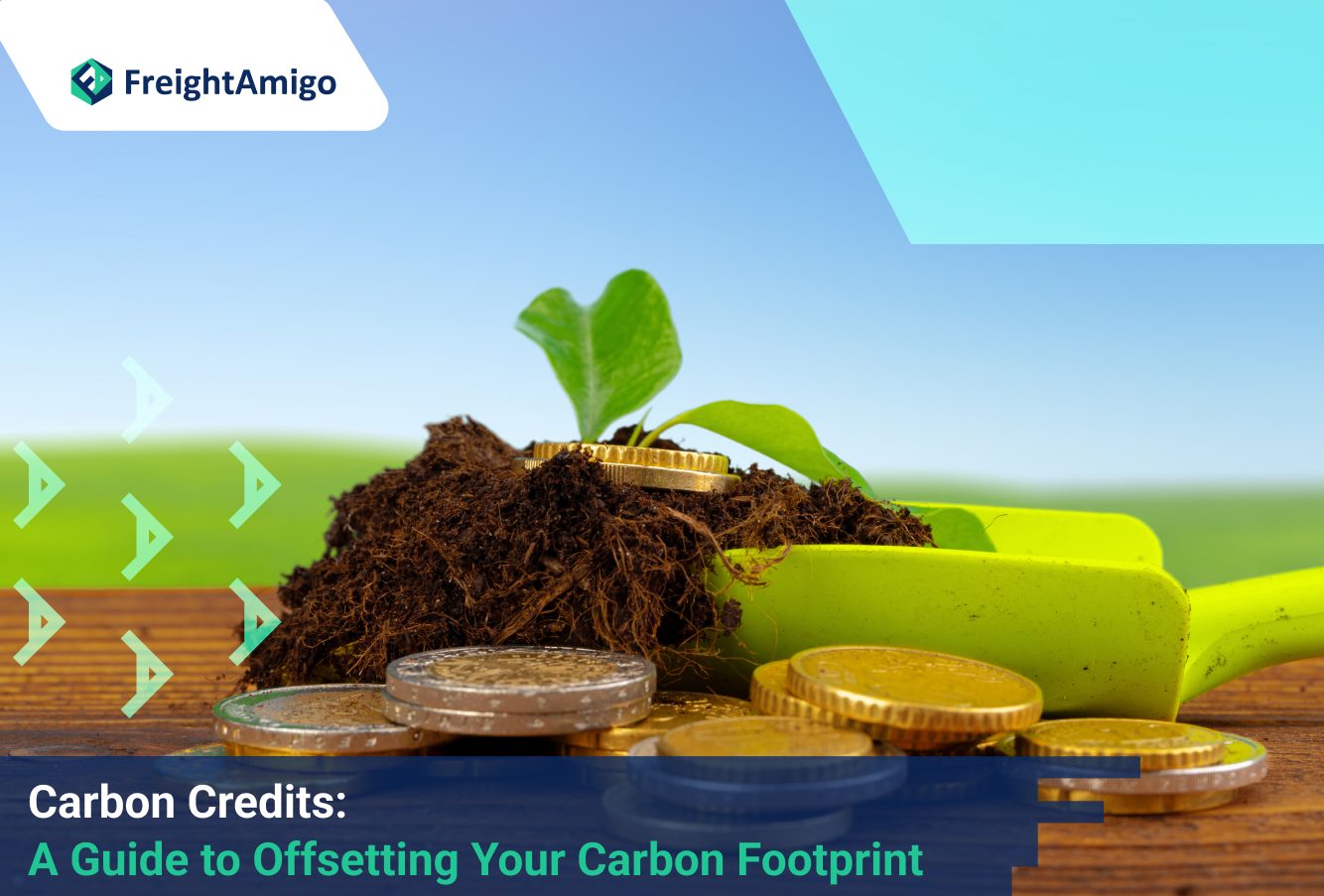Author Name: Tiffany Lee – Marketing Analyst at FreightAmigo
Carbon credits, also known as carbon offsets, have gained significant attention in recent years as a means to mitigate the environmental impact of greenhouse gas (GHG) emissions. As the world grapples with the effects of climate change, individuals and companies are increasingly seeking ways to reduce their carbon footprint and contribute to a more sustainable future. In this comprehensive guide, we will explore what carbon credits are, how they work, and their role in offsetting carbon emissions.
Want To Compare The Best Express, Air Freight, Sea Freight, Rail Freight & Trucking Rates So As To Have Better Control On Cost?
Introduction
The increasing awareness of climate change and its detrimental effects has prompted individuals and organizations to take action. Carbon credits have emerged as a tool to help offset the carbon emissions produced by various activities. By understanding the concept of carbon credits, individuals and companies can make informed decisions to reduce their environmental impact.
What Are Carbon Credits?
Definition and Purpose
Carbon credits, also referred to as carbon offsets, are permits that allow the owner to emit a certain amount of carbon dioxide or other greenhouse gases. Each credit represents the reduction, removal, or avoidance of one metric ton of carbon dioxide or its equivalent in other greenhouse gases. The purpose of carbon credits is to incentivize companies and individuals to support emission reduction projects and offset their own carbon footprint.
Cap-and-Trade System
The carbon credit system operates on the principle of cap-and-trade. Under this system, companies are allocated a specific number of credits that correspond to their allowable emissions. The total number of credits issued is gradually reduced over time, creating a cap on emissions. If a company exceeds its allocated credits, it must purchase additional credits from entities that have surplus allowances. This system encourages companies to reduce their emissions and rewards those that can surpass their targets by selling their excess credits.
How Do Carbon Credits Work?
Emission Reduction Projects
Carbon credits are generated through various types of emission reduction projects. These projects can be categorized into nature-based solutions and engineered solutions. Nature-based solutions focus on preserving or restoring ecosystems, such as reforestation efforts or regenerative agriculture practices. Engineered solutions involve technologies that capture and store carbon dioxide, such as carbon capture and storage (CCS) or direct air capture (DAC).
Carbon Credit Trading
Once carbon credits are generated, they can be traded on carbon credit marketplaces. These marketplaces connect buyers, who want to offset their emissions, with sellers, who have generated credits through emission reduction projects. The price of carbon credits can vary depending on factors such as project type, location, and certification. By purchasing carbon credits, individuals and companies can effectively neutralize their own emissions by supporting projects that reduce or remove an equivalent amount of greenhouse gases.
The Benefits of Carbon Credits
Financial Incentives for Emission Reduction
One of the key benefits of carbon credits is the financial incentive they create for companies to reduce their carbon emissions. By setting a price on carbon, companies are motivated to invest in cleaner technologies and operational practices to avoid the need to purchase additional credits. This financial pressure encourages innovation and the adoption of more sustainable business practices.
Support for Sustainable Development
Carbon credits also play a role in supporting sustainable development initiatives. Many emission reduction projects, particularly nature-based solutions, have co-benefits beyond carbon mitigation. These projects can contribute to biodiversity conservation, improve local livelihoods, enhance water quality, and protect ecosystems. By purchasing carbon credits from such projects, individuals and companies can contribute to broader sustainability goals.
Contributions to Climate Change Mitigation
Carbon credits have the potential to make a significant impact in the global fight against climate change. By supporting emission reduction projects, carbon credits enable the reduction, removal, or avoidance of greenhouse gases. This collective effort can contribute to achieving ambitious climate targets, such as the Paris Agreement’s goal of limiting global warming to well below 2 degrees Celsius above pre-industrial levels.
Types of Carbon Credit Projects
Nature-Based Solutions
Nature-based solutions focus on preserving or restoring ecosystems to sequester carbon dioxide and reduce greenhouse gas emissions. These projects encompass activities such as reforestation, afforestation, and sustainable land management practices. By increasing forest cover and improving land management, nature-based solutions can effectively capture and store carbon dioxide from the atmosphere.
Engineered Solutions
Engineered solutions involve technological interventions to capture and store carbon dioxide emissions. Carbon capture and storage (CCS) technologies capture carbon dioxide from industrial processes and store it underground or repurpose it for other uses. Direct air capture (DAC) technologies directly remove carbon dioxide from the atmosphere. These engineered solutions offer opportunities for carbon sequestration and emission reduction in sectors that are difficult to decarbonize.
Carbon Credit Standards and Certifications
Verified Carbon Standard (VCS)
The Verified Carbon Standard (VCS) is one of the most widely recognized standards for carbon credits. It provides guidelines and requirements for measuring, quantifying, and verifying emission reduction projects. Projects that meet the VCS requirements can generate VCS credits, which are considered reliable and transparent in the carbon credit market.
Gold Standard
The Gold Standard is another prominent certification standard for carbon credits. It focuses on projects that have additional sustainability benefits, such as poverty reduction, gender equality, and biodiversity conservation. Gold Standard credits are known for their rigorous criteria and holistic approach to sustainable development.
Climate Action Reserve
The Climate Action Reserve is a nonprofit organization that operates a carbon offset registry and certification program. It provides a platform for projects to register and verify their emission reductions. Climate Action Reserve credits are widely recognized in the voluntary carbon market and are trusted for their robust methodologies and rigorous verification process.
Carbon Credit Marketplaces and Brokers
3Degrees
3Degrees is a carbon credit marketplace that connects buyers with project developers. It offers a diverse range of projects and credits, allowing companies to select the most suitable options for offsetting their emissions. 3Degrees also provides consulting services to help companies develop comprehensive sustainability strategies.
South Pole Group
The South Pole Group is a leading provider of carbon credits and sustainability solutions. It offers a wide range of projects across different sectors and geographies. South Pole Group’s expertise in project development, verification, and certification ensures the quality and integrity of the credits it offers.
Terrapass
Terrapass is a carbon offset provider that offers a variety of projects and credits to help individuals and businesses reduce their carbon footprint. Terrapass provides transparent information about each project, allowing buyers to make informed decisions. The company also offers a carbon footprint calculator to help individuals estimate their emissions and offset them accordingly.
Evaluating Carbon Credit Quality
Additionality
Additionality refers to the concept that a carbon credit project would not have occurred without the expected revenue from selling the credits. It ensures that the emission reduction achieved through the project is additional to what would have happened without the project. Robust methodologies and rigorous assessment processes are used to evaluate the additionality of projects.
Quantification
Quantification is the process of measuring and determining the volume of greenhouse gas emissions reduced, avoided, or removed by a project. Standardized methodologies are used to establish baselines and calculate the emission reductions achieved by the project. It is important to understand the quantification approach used by a project to ensure the accuracy and reliability of the carbon credits generated.
Leakage
Leakage refers to the risk that emissions reduced or avoided in one location might be displaced to another location or sector. It is important for carbon credit projects to account for potential leakage and ensure that the emission reductions achieved are not offset by increased emissions elsewhere. Robust project design and monitoring mechanisms help mitigate the risk of leakage.
Permanence Risk
Permanence risk refers to the possibility that the carbon benefits achieved through a project might be temporary rather than permanent. For example, forest conservation projects face the risk of deforestation in the future, which would release the stored carbon back into the atmosphere. Projects that address permanence risk through long-term commitments and safeguards provide more reliable and credible carbon credits.
Vintage
The vintage of carbon credits refers to the year in which they were issued by the project. Recent vintage credits are generally preferred as they align with updated standards and methodologies. They are also more likely to represent projects that are actively implementing emission reduction measures and incorporating the latest scientific knowledge.
Co-benefits
Co-benefits are additional positive impacts that result from carbon credit projects. These can include socio-economic benefits such as job creation, improved livelihoods, enhanced biodiversity, and improved water quality. Projects that generate co-benefits provide a more holistic approach to sustainability and can contribute to broader development goals.
Challenges and Controversies
Credibility and Greenwashing Concerns
The carbon credit market faces challenges related to credibility and greenwashing. Greenwashing refers to the practice of making false or exaggerated claims about the environmental benefits of a product or service. Some carbon credits have been criticized for their lack of transparency and failure to deliver the promised emission reductions. It is important for buyers to conduct due diligence and choose credits from reputable sources that adhere to robust standards and certification processes.
Lack of Standardization
The carbon credit market lacks standardized methodologies and unified certification processes. This lack of standardization makes it difficult for buyers to compare and evaluate different credits. Various standards and registries have emerged to address this issue, but there is still a need for greater harmonization and transparency in the market.
Carbon Credits and Net-Zero Goals
Corporate Net-Zero Targets
Many companies have set ambitious net-zero targets as part of their sustainability strategies. Net-zero targets typically involve reducing emissions from internal operations and supply chains and offsetting the remaining emissions through the purchase of carbon credits. Carbon credits play a crucial role in helping companies achieve their net-zero goals by supporting emission reduction projects beyond their own operational scope.
Role of Carbon Offsets in Achieving Goals
Carbon offsets, in the form of carbon credits, provide flexibility and enable companies to address emissions that are challenging to eliminate entirely. By investing in high-quality carbon credits, companies can support emission reduction projects that deliver measurable and verifiable results. Carbon offsets can complement internal emission reduction efforts and contribute to an overall reduction in the carbon footprint.
Conclusion
Carbon credits play a vital role in the global effort to combat climate change and reduce greenhouse gas emissions. By supporting emission reduction projects and offsetting carbon footprints, individuals and companies can contribute to a more sustainable future. However, it is essential to carefully evaluate the quality and credibility of carbon credits to ensure their effectiveness in achieving emission reduction goals. With robust standards, transparent marketplaces, and informed decision-making, carbon credits can make a significant impact in the transition to a low-carbon economy.
There Are Different Options For Cargo Transportation. If You Want To Choose The Most Convenient And Suitable Solution, It Is Best To Have The Full Support Of Logistics Experts! If You Are Planning To Ship Goods Overseas, Please Go To The FreightAmigo Page For Inquiries.
===
Read More:
【Cosmetic Product Recycling】 A Guide to Sustainable Reverse Logistics
【Rise of Green Supply Chain】 Pioneering Sustainable Practices in Logistics
【ESG in Logistics】 How ESG Practices Drive Social Responsibility in Logistics
===
If you have any inquiries on logistics/supply chain, feel free to contact FreightAmigo now:
Chat with us online OR
Phone : +852 28121686
WhatsApp: +852 27467829









































